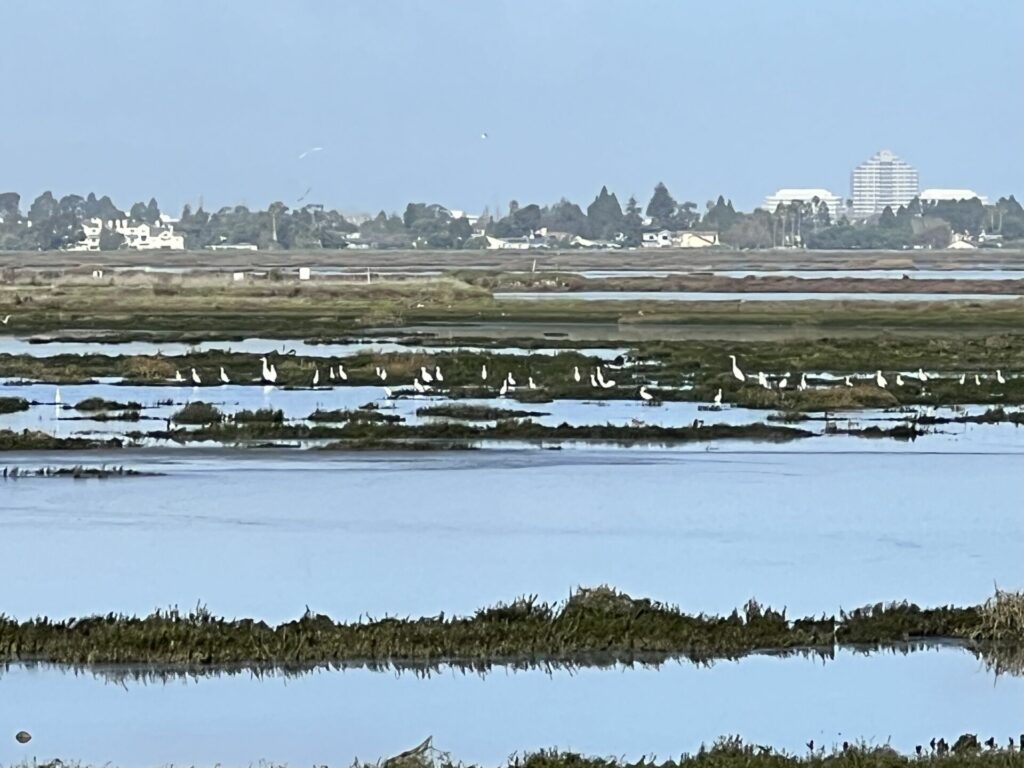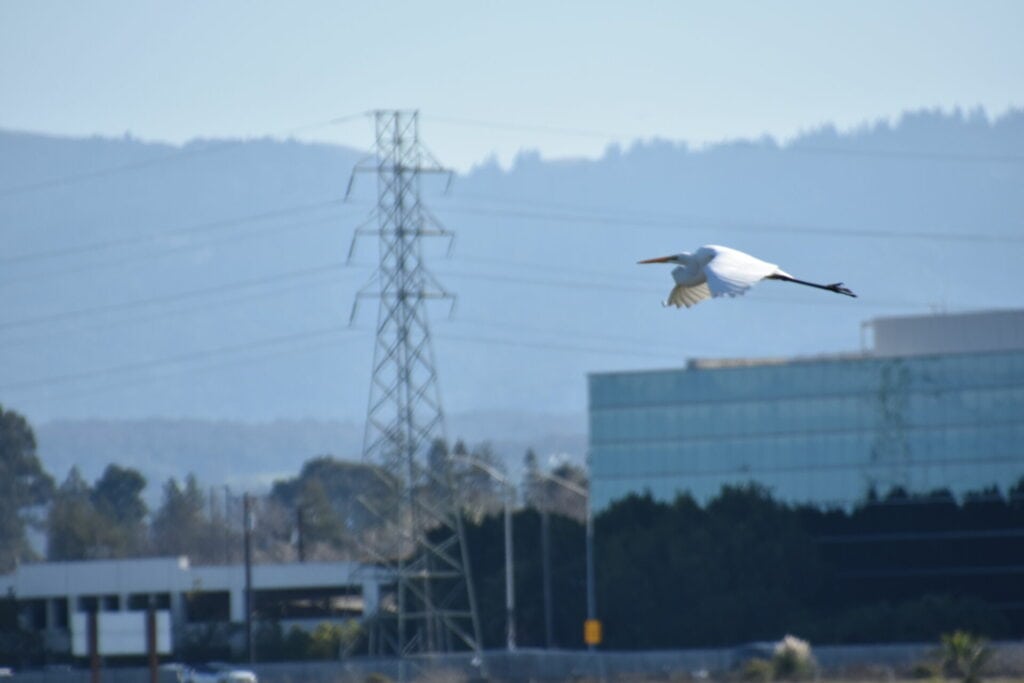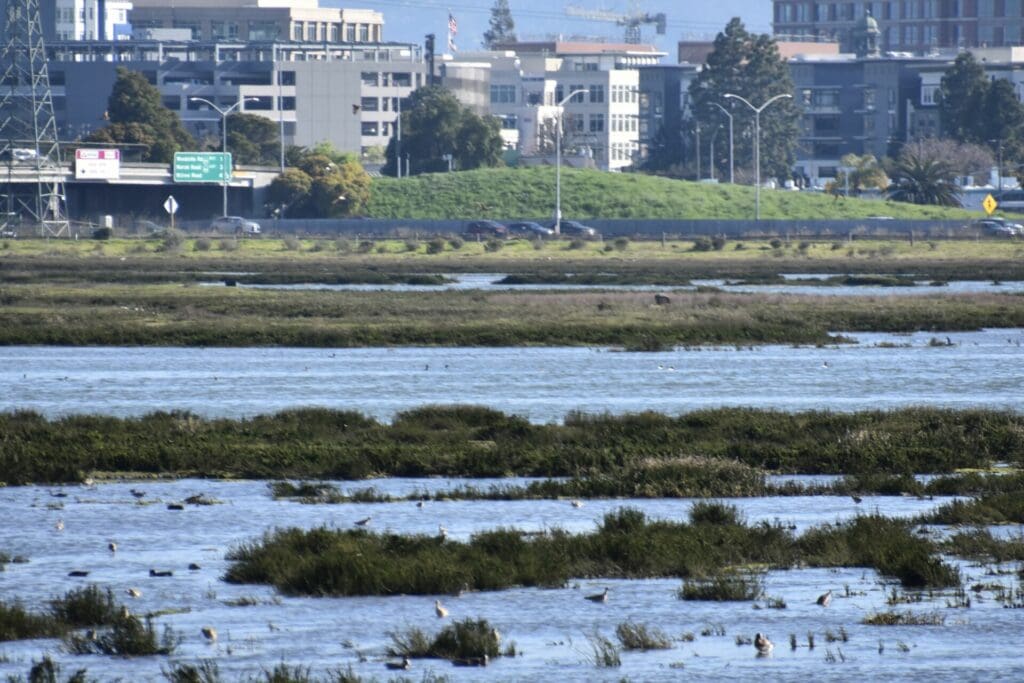Birding the Bay Islands: Bair Island’s Tidal Food Court
by Helen J. Doyle and Jeanette Pettibone
Bair Island’s restored tidal wetlands provide a variety of food found in high tide waters and low tide exposed mudflats for both year-round residents and thousands of birds migrating through or overwintering in the Bay Area.
Located just east of Highway 101 near Redwood City, Bair Island is part of the Don Edwards San Francisco Bay National Wildlife Refuge, an impressive multi-agency effort to restore the South Bay’s natural wetlands. Bair Island’s primary habitat is tidal wetlands, dominated by salt marsh-loving plants like pickleweed and gumplant, bounded on the landward side by shrubland. Twice a day the exposed mudflats serve up abundant food for a variety of shorebirds, waterbirds, gulls and terns. Shorebirds are especially cooperative and fun to watch in such an exposed and expansive landscape. They move slowly as they use their bills to forage in the mud, their long legs keeping their bodies above the water. A terrific time to watch the Bair Island food court is on ebb tide, with the birds descending on the freshly exposed mudflats as the tide goes out. This is a great place to bring a scope, if you have one.
Like Mare Island further north in the San Pablo Bay, Bair Island may not have always been an island like it is today. As elsewhere in the San Francisco and San Pablo Bays, the shoreline has been molded and shaped to serve agricultural and industrial uses. In the 1920s, cattle were raised here by Fred Bair, for whom the island was named. Subsequently, they were part of the complex of salt evaporation ponds along the Bay shoreline. In the 1970s and 1980s, housing developments were proposed for Bair Island until local conservation efforts succeeded in protecting it and ultimately incorporating it into the extensive Don Edwards Refuge. Now the approximately 3,000 acres of Bair Island is part of the South Bay Salt Pond Restoration Project, converting just over 15,000 acres of industrial salt ponds back to tidal wetlands and other habitats. This and other efforts to restore native habitat and prepare for sea level rise were recently funded through the federal Bipartisan Infrastructure Law announced in March by US Secretary of the Interior Deb Haaland, and Wade Crowfoot, Secretary of the California Natural Resources Agency.

On our first outing to Bair Island, a calm late January morning between winter storms, we neglected to coordinate with the tides. As the flood tide slowly submerged the mudflats, the shorebirds headed to more exposed terrestrial locations. The Double-crested Cormorants drying their wings on the scattered island refuges flew off. The waterbirds continued their seemingly effortless foraging. We identified 28 species, including a few shrubland-loving sparrows and phoebes. For multiple species, we saw 50 or more individual birds, including Northern Shovelers, American Avocets, Long-billed Curlews, Marbled Godwits, Double-crested Cormorants, and Snowy Egrets.

At the time, eBird considered our count of 55 Snowy Egrets unusually high. Just a few weeks later Dominik Mosur did a one by one tally of Snowy Egrets for the high count record at Bair Island. On a second visit to Bair Island in early February, the lower tide brought a few birds to forage closer to the trail, making it easier to photograph them. We were reminded that changes to habitat, whether human-caused, seasonal, or twice daily tides, greatly influence local bird populations and behaviors.

Bair Island is actually made up of three islands, imaginatively called Inner, Middle, and Outer, which are separated by tidal channels. Of the three islands, about 2,000 acres of Middle and Outer Islands are part of the Bair Island Ecological Reserve and only accessible by boat. You can explore Inner Island by crossing a pedestrian bridge and walking along an accessible hiking trail built atop a levee, with two large observation decks at either end. The San Francisco Bay Trail will eventually follow the Inner Bair Island trail, connecting Steinberger Slough to Redwood Creek.


Like many of the Bay’s tidal wetlands, Bair Island borders an urban area, with constant freeway traffic and low-flying planes to and from nearby San Carlos Airport. There can be something both heartwarming and distressing about birding while cars and airplanes zoom by, but Bair Island is part of a restoration success story. The San Francisco Bay/Estuary was recognized by the United States as a Wetland of International Importance and additionally acknowledged as a site of Hemispheric Importance by the Western Hemisphere Shorebird Reserve Network for hosting more wintering shorebirds than any other estuary along the US Pacific Coast south of Alaska. Bair Island is a vital part of this network.

Bair Island and other locations in the Don Edwards San Francisco Bay National Wildlife Refuge offer ample, free, and reasonably accessible opportunities to bird the Bay’s tidal wetlands habitat, whatever the season.
Helen J. Doyle is a California Naturalist and educator dedicated to the environment, public education, and equity and justice. A biologist by training, she shares her love of nature as a docent and writer. She volunteers with several Bay Area organizations, such as Año Nuevo State Park, the Gardens of Golden Gate Park, and the Amah Mutsun Land Trust, and serves on the advisory council of Nature in the City, a San Francisco nonprofit that connects people to nature. (Helen on LinkedIn)
Jeanette Pettibone developed and taught her first class for GGBA – San Francisco Habitats and Their Birds – this past Spring and she’s been a member of GGBA’s San Francisco Conservation Committee since late 2022. She volunteers as a waterbird docent on Alcatraz and is excited to start a banding apprenticeship with the Golden Gate Raptor Observatory this fall. She’s also been a docent with the Fine Arts Museums of San Francisco since 2011 and gives art talks around the Bay Area. (Jeanette on LinkedIn)
